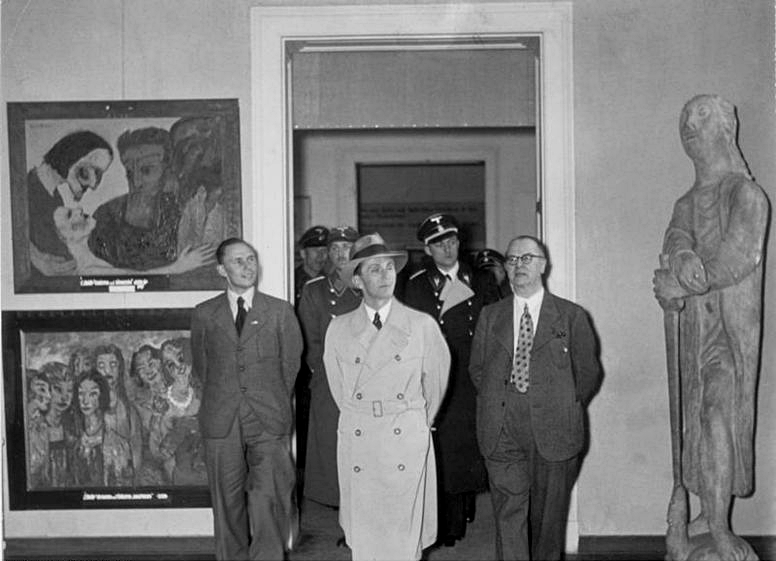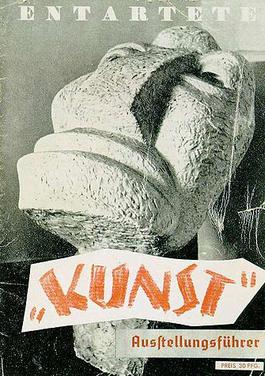
Goebbels views the Degenerate Art exhibition. Image Source: German Federal Archives
On July 19, 1937, the Degenerate Art Exhibition (German: Die Ausstellung “Entartete Kunst“) was opened in the Institute of Archeology in the Munich Hofgarten. The exhibition presented 650 works of art, confiscated from German museums, and was staged in counterpoint to the concurrent Great German Art Exhibition. The exhibition included works of Marc Chagall, Wassily Kandinsky, Ernst Ludwig Kirchner, Paul Klee, Franz Marc, and Emil Nolde.[3,4,6,7,8] It was not a singular event in Munich in 1937, but fell with the “First Great German Art Exhibition” as a counter-exhibition in a framework with a large number of cultural events in the “Festival Summer Munich 1937”.
Prelude and the First Great German Art Exhibition
As Adolf Hitler gained power in Germany in 1933, his party was quickly intending to ‘clean’ the country’s culture of ‘degeneracy’. Next to the numerous book burnings that were organized all over, many artists and musicians were released from their teaching positions and curators of most museums were replaced by members of the Nazi Party. The Reichskulturkammer was established and administered by Reich Minister of Propaganda Joseph Goebbels. Hitler started denouncing Modern art and its practitioners as “incompetents, cheats and madmen” in 1934. It is believed that in 1937, when the Great German Art Exhibition was planned, a jury partly selected by Goebbels began deciding on which of the 15,000 submitted works should be added to the exhibition. On June 2, Gauleiter Adolf Wagner had reported to Joseph Goebbels that problems had arisen in the selection of works for the First Great German Art Exhibition because the jury, which consisted of artists, had followed its own taste and opinion of the artists rather than the official view of art in making its choice. Goebbels called the works presented to him “dismal examples of art Bolshevism” and flew with Hitler to Munich on June 5, where he personally intervened in the selection. Hitler then connected the opening of the House of German Art in Munich with the First Great German Art Exhibition and gave his most programmatic speech on art on this occasion. According to the State Statistical Office, more than 1 million people visited Munich in 1937. This was the city’s best attendance record up to that time.
The Counter Event against Modern Art
The Reich Ministry for Popular Enlightenment and Propaganda began planning an exhibition in the spring of 1937 to present the achievements of the National Socialist movement since 1933 in the social and political fields. It was held in Berlin from May to August 1937 and featured 3,000 photographs, statistics, and graphics depicting economic success. In addition, it was considered to conduct a parallel campaign against Modern Art. “Art writer” Wolfgang Willrich was ordered to compile material for an exhibition with the planned title “Gebt mir vier Jahre Zeit” (Give me four years). It was made clear to Willrich that it was the Propaganda Minister’s intention that “a clear contrast be created (a black-and-white contrast, as it were) between, as he put it, ‘the arts of yesteryear and the art of our day.'” Willrich doubted that a larger number of artworks could be obtained, since most modern artworks were still protected by sympathetic museum directors. However, in the same month, Willrich began sifting through material for the planned exhibition in Berlin. In the process, both gained access to holdings that had been taken down “for their protection” in the years since 1933 and placed in the magazines.

Entartete Kunst, poster for the 1938 exhibition in the house of art at Koenigsplatz in Munich
The Controversial Exhibition
The Munich exhibition was organized by Adolf Ziegler, who also directed the previous seizures. The controversial exhibition was hosted at the Institute of Archeology in the Hofgarten in Munich and most of the 650 works were displayed without frames. The art pieced included sculptured, paintings as well as prints by Marc Chagall, Georg Grosz, Wassily Kandinsky, Ernst Ludwig Kirchner, Paul Klee, Georg Kolbe, Wilhelm Lehmbruck, Franz Marc, Emil Nolde and others. As the exhibition focused on German works, the confiscated pieces by Pablo Picasso,[5] Jean Metzinger, Albert Gleizes and Piet Mondrian were not displayed. The event lasted until 30 November 1937 and more than 2 million people came to visit. In order to achieve an effect that appeared “chaotic,” the works in the exhibition rooms were deliberately hung in an unflattering manner and had vituperative slogans written on the walls. Thus, the entire exhibition was designed for its propagandistic effect. Together with its counterpart, the “First Great German Art Exhibition,” the “Degenerate Art” exhibition was conceived as a double propaganda show in which works of art considered “degenerate” were systematically juxtaposed with the “pure German art” promoted by the system. Indeed, this juxtaposition was also necessary because there were no clear definitions of “degenerate” and “pure German” art, and both were only given contours in direct confrontation. The exhibition was designed to radically attack the art rejected by the National Socialists.

Cover of the exhibition program: Degenerate Art exhibition, 1937. The word “Kunst”, meaning art, is in scare quotes; the artwork is Otto Freundlich’s sculpture Der Neue Mensch
Another Degenerate Art Exhibition was hosted a few months later in Berlin, and later in Leipzig, Düsseldorf, Weimar, Halle, Vienna and Salzburg, to be seen by another million or so people. 300 of the exhibited works were apparently purchased or otherwise appropriated by art dealer Hildebrand Gurlitt who had reported them destroyed by bombardments; however, they resurfaced when details of the Gurlitt Collection which had been inherited by his son Cornelius were made known in 2013. Cornelius Gurlitt left the collection to the Museum of Fine Arts Bern in Switzerland which in November 2017 exhibited a number of them in an exhibition entitled “Gurlitt: Status Report: Degenerate Art – Confiscated and Sold“.
Aftermath
In 2014 the Neue Galerie New York staged Degenerate Art: The Attack on Modern Art in Nazi Germany, an exhibition bringing together paintings and sculptures from the 1937 exhibition along with films and photos of the original installations, promotional and propaganda materials and some surviving Nazi-approved art from the official exhibition set up to contrast with the modernist and avant-garde works the Nazis considered “degenerate”. The Museum of Modern Art has now established a digital exhibit that showcases artwork from the Degenerate Art Exhibition.[10]
1937 Munich Exhibition of Degenerate Art, [12]
References and Further Reading:
- [1] Entartete Kunst (Degenerate Art), complete inventory of over 16,000 artworks confiscated by the Nazi regime from public institutions in Germany, 1937-1938, Reichsministerium für Volksaufklärung und Propaganda. Victoria and Albert Museum, 2014
- [2] Munich 1937: The Development of Two Pivotal Art Exhibitions
- [3] Marc Chagall and Modernism’s Golden Age, SciHi Blog
- [4] Emil Nolde – the First Expressionist, SciHi Blog
- [5] Pablo Picasso – A Giant in Art, SciHi Blog
- [6] Wassily Kandinsky – the First Expressionist, SciHi Blog
- [7] Paul Klee – One of the most Important Artists of Classical Modern Art, SciHi Blog
- [8] Franz Marc – German Expressionism and Der blaue Reiter, SciHi Blog
- [9] Explore ‘Entartete Kunst’: The Nazis’ inventory of ‘degenerate art’, Victoria and Albert Museum. 2019.
- [10] “Degenerate Art”. MoMA.
- [11] Degenerate Art Exhibition at Wikidata
- [12] 1937 Munich Exhibition of Degenerate Art, smilingoff @ youtube





